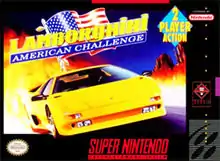Lamborghini American Challenge
Lamborghini American Challenge (previously released as Crazy Cars III) is a 1994 racing video game developed and published by Titus France for the Super NES, Amiga CD32, Atari ST, Commodore 64, Game Boy and PC DOS.
| Lamborghini American Challenge | |
|---|---|
 Super NES North American cover art | |
| Developer(s) | Titus France |
| Publisher(s) | Titus France |
| Composer(s) | Richard Hooper (Amiga) Frederic Prados (SNES) Thorsten Mitschele (Game Boy) |
| Platform(s) | Super NES, Amiga CD32, Game Boy, PC DOS |
| Release | 1994 |
| Genre(s) | Racing game |
| Mode(s) | Single-player, Two player challenge |
The game is essentially an upgrade from Titus's previous entry in the Crazy Cars franchise, Crazy Cars III.[1] It adds a two player mode and a few more options, the game's most notable feature is its jazz fusion soundtrack.
Gameplay
The objective of this game is to end up the undisputed champion of highly illegal street racing throughout the entire United States. To do so, the player must race against a group of computer-controlled opponents in a variety of illegal races across the country. The races are divided into three leagues, each one with increasingly harder opponents, and the player needs to regularly upgrade their Lamborghini Diablo in order to keep them above the other racers, by using the American currency from bets as well as the bonuses earned by succeeding in the races in first place.
Scenarios
The races themselves take place in a variety of scenarios (mountain roads, the desert, urban settings) and they include weather conditions such as rain and snow. At the end of each league, and in order to be able to join the next one, the player has to go through a "challenge", consisting of a timed race in a highway infested with trucks.
Reception
| Publication | Score |
|---|---|
| CGW | |
| Computer Player | 5/10 (PC)[3] |
| Electronic Games | B- (PC)[4] |
| Zero | 88/100 (Amiga)[5] |
| Publication | Score |
|---|---|
| GamePro | 3.38/5 (GB)[lower-alpha 1] |
| GB Action | 86% (GB)[7] |
| NMS | 39/100 (GB)[8] 64/100 (SNES)[8] |
| Nintendo Power | 2.98/5 (SNES)[lower-alpha 2] |
| SNES Force | 70/100 (SNES)[10] |
| Super Play | 73% (SNES)[11] |
| Super Pro | 80/100 (SNES)[12] |
Tony Dillon of CU Amiga gave the Amiga version an 88 percent rating and called it "the most competent and enjoyable game that Titus have ever produced, and a game well worth having. It might not be as smooth as Lotus, as fast as F1 or as playable as Jaguar, but it's still a cool game".[1] Computer Gaming World gave the game three stars out of five, stating that "For straight ahead thrills and spills, [it] might be the ticket".[13]
Peripherals
The Super NES version supports the Super NES Mouse and Super Scope. When the game is played with either accessory, the player can access a different game mode in which it is possible to destroy the opponent by shooting them (the original bet mode is not present). The infamous saving system from computer versions is also substituted by a password system.
See also
Notes
References
- Dillon, Tony (February 1994). "Lambourghini review". CU Amiga. p. 77. Retrieved September 7, 2015.
- Goble, Gordon (August 1994). "Lamborghini American Challenge". Computer's Gaming World. No. 121. pp. 61–62.
- Dulin, Ron (February 1995). "Lamborghini American Challenge". Computer Player. No. 9. p. 78.
- Kunkel, Bill (September 1994). "Lamborghini American Challenge". Electronic Games. p. 94.
- "Crazy Cars III". Zero. No. 35. September 1992. pp. 58–59.
- LaMancha, Manny (September 1994). "Lamborghini American Challenge". GamePro. No. 62. p. 122.
- Sharp, Andy (December 1993). "Lamborghini American Challenge". GB Action. No. 19. pp. 12–13.
- "Lamborghini American Challenge". Nintendo Magazine System. No. 14. November 1993. pp. 84–85.
- "Lamborghini American Challenge". Nintendo Power. Vol. 55. December 1993. pp. 104, 107.
- "Lamborghini American Challenge". SNES Force. No. 7. December 1993. pp. 56–58.
- "Top Gear 2 vs. Lamborghini American Challenge". Super Play. No. 13. November 1993. pp. 40–41.
- "Lamborghini American Challenge". Super Pro. No. 12. November 1993. p. 45.
- Goble, Gordon (August 1994). "Four More For The Road". Computer Gamring World. pp. 60–64.
External links
- Lamborghini: American Challenge at MobyGames
- Lamborghini: American Challenge at GameFAQs
- SNES Soundtrack information at SNESmusic.org